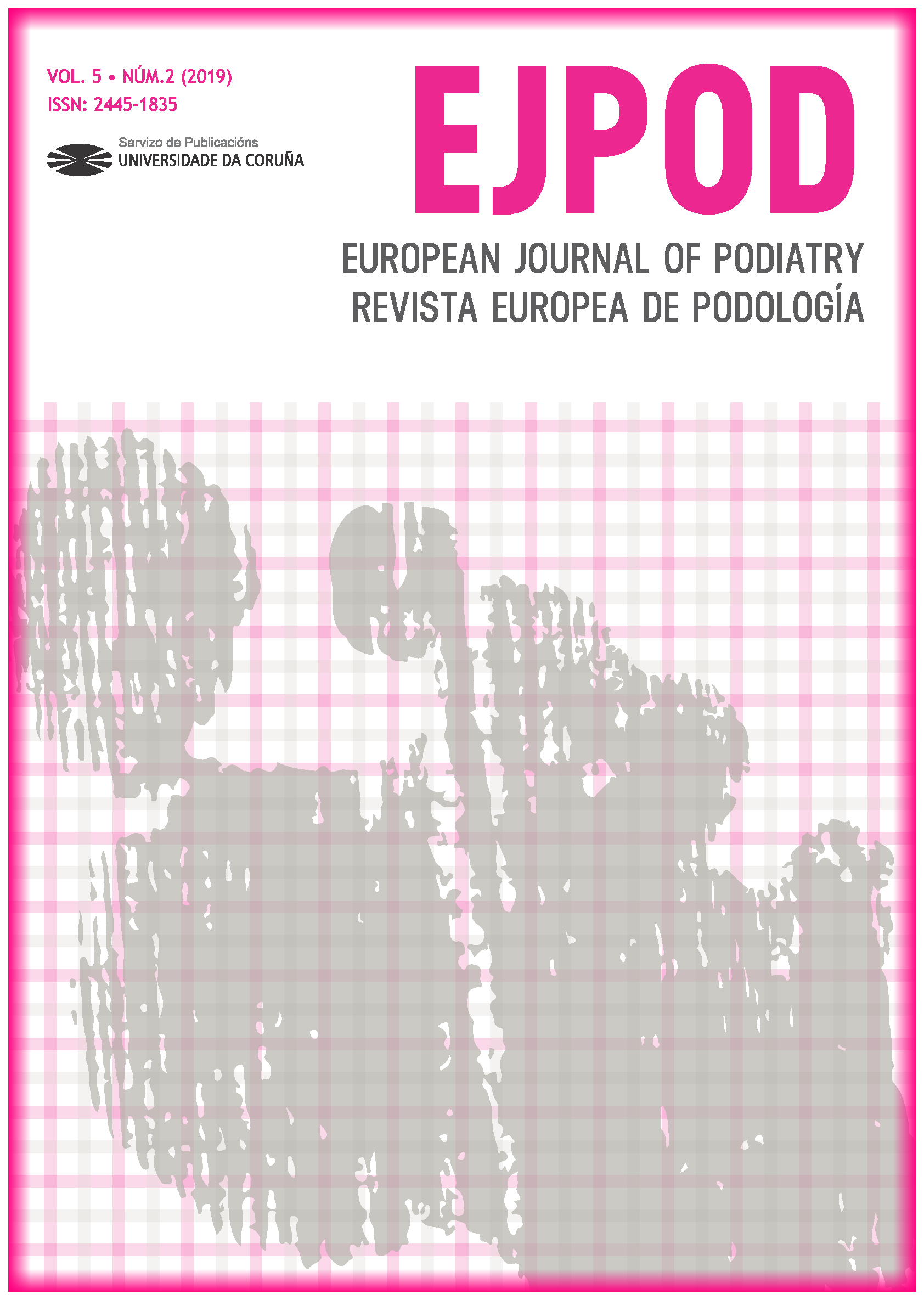Análisis de los desequilibrios musculares de la cadera en corredores aficionados
Contenido principal del artículo
DOI:
https://doi.org/10.17979/ejpod.2019.5.2.5727Resumen
Objetivo. La fuerza muscular es considerada un factor importante tanto en el rendimiento de los deportistas como en el desarrollo de diversas lesiones. Aunque el ratioagonista: antagonista es uno de los mejores predictores de lesión muscular, no existen valores de referencia para desequilibrios y asimetrías en la cadera de corredores aficionados siendo el objetivo propuesto de esta investigación.
Material y métodos. Se realizaron 3 mediciones de fuerza de los 6 grupos musculares de la cadera (abductores, aductores, flexores, extensores, rotadores externos y rotadores internos) con un dinamómetro de resistencia manual (Microfet 2 Handheld dynamometer) en 30 corredores aficionados que recorrían un mínimo de 25 kilómetros semanales.
Resultados. 29 sujetos presentaron desequilibrios en el ratio Flexión/Extensión y el 100% a favor de la extensión en ambos miembros. Se encontraron diferencias significativas en el par muscular de los rotadores (p=0,047) en frecuencia de desequilibrios entre miembros. El ratio Dominante/No dominante se situó entre 0,9 y 1,1 en todas las musculaturas.
Conclusiones. Se encontraron desequilibrios musculares de cadera en la mayoría de los voluntarios, tanto en el lado dominante como en el no dominante. Aproximadamente un tercio de los sujetos presentaron desequilibrios entre ambas caderas en rotadores y abductores.
Palabras clave:
Detalles del artículo
Referencias
Brown S, Feldman E, Cross M, Helms E, Marrier B, Samozino P et al. The Potential for a Targeted Strength-Training Program to Decrease Asymmetry and Increase Performance: A Proof of Concept in Sprinting. Int J Sport Physiol Perform. 2017;12(10):1392-1395. https://doi.org/10.1123/ijspp.2016-0590
Cheung R, Smith A, Wong D. H:Q Ratios and Bilateral Leg Strength in College Field and Court Sports Players. J Hum Kinet. 2012;33(1):63-71. https://doi.org/10.2478/v10078-012-0045-1
Christopher S, McCullough J, Snodgrass S, Cook C. Do alterations in muscle strength, flexibility, range of motion, and alignment predict lower extremity injury in runners: a systematic review. Arch Physiother. 2019;9(1). https://doi.org/10.1186/s40945-019-0054-7.
Dellagrana R, Diefenthaeler F, Carpes F, Hernandez S, Campos W. Evidence for isokinetic knee torque asymmetries in male long distance-trained runners. Int J Sport Phys Ther. 2015;10(4):514. https://www.ncbi.nlm.nih.gov/pmc/articles/PMC4527198/pdf/ijspt-08-514.pdf
Finnoff J, Hall M, Kyle K, Krause D, Lai J, Smith J. Hip Strength and Knee Pain in High School Runners: A Prospective Study. PM&R. 2011;3(9):792-801. https://doi.org/10.1016/j.pmrj.2011.04.007
Hadzic V, Sattler T, Veselko M, Markovic G, Dervisevic E. Strength Asymmetry of the Shoulders in Elite Volleyball Players. J Athl Train. 2014;49(3):338-344. https://doi.org/10.4085/1062-6050-49.2.05
Hedt C, Pearson J, Lambert B, McCulloch P, Harris J. Sex-Related Hip Strength Measures Among Professional Soccer Players. J Strength Cond Res. 2019;1. https://www.researchgate.net/profile/Bradley_Lambert/publication/331047857_Sex-Related_Hip_Strength_Measures_Among_Professional_Soccer_Players/links/5c6324a5299bf1d14cc1eeff/Sex-Related-Hip-Strength-Measures-Among-Professional-Soccer-Players.pdf
Ireland M, Willson J, Ballantyne B, Davis I. Hip Strength in Females With and Without Patellofemoral Pain. J Orthop Sport Phys Ther. 2003;33(11):671-676. https://doi.org/10.2519/jospt.2003.33.11.671
Janssen M, Scheerder J, Thibaut E, Brombacher A, Vos S. Who uses running apps and sports watches? Determinants and consumer profiles of event runners’ usage of running-related smartphone applications and sports watches. PloS One. 2017;12(7):e0181167. https://doi.org/10.1371/journal.pone.0181167
Niemuth P, Johnson R, Myers M, Thieman T. Hip Muscle Weakness and Overuse Injuries in Recreational Runners. Clin J Sport Med. 2005;15(1):14-21. https://journals.lww.com/cjsportsmed/Abstract/2005/01000/Hip_Muscle_Weakness_and_Overuse_Injuries_in.4.aspx
Orchard J, Marsden J, Lord S, Garlick D. Preseason hamstring muscle weakness associated with hamstring muscle injury in Australian footballers. Am J Sports Med. 25: 81-85, 1997 https://doi.org/10.1177/036354659702500116
Prentice WE, Voight MI. Techniques in Musculoskeletal Rehabilitation. New York: McGraw Hill; 2001.
Rodriguez R. Measuring the Hip Adductor to Abductor Strength Ratio in Ice Hockey and Soccer Players: A Critically Appraised Topic. J Sport Rehabil. 2019;00:1-6 https://doi.org/10.1123/jsr.2018-0250
Tyler T, Nicholas S, Campbell R, McHugh M. The Association of Hip Strength and Flexibility with the Incidence of Adductor Muscle Strains in Professional Ice Hockey Players. Am J Sport Med. 2001;29(2):124-128. https://doi.org/10.1177/03635465010290020301
Wollin M, Thorborg K, Welvaert M, Pizzari T. In-season monitoring of hip and groin strength, health and function in elite youth soccer: Implementing an early detection and management strategy over two consecutive seasons. J Sci Med Sport. 2018;21(10):988-993. https://doi.org/10.1016/j.jsams.2018.03.004



